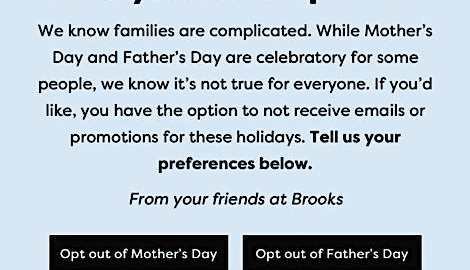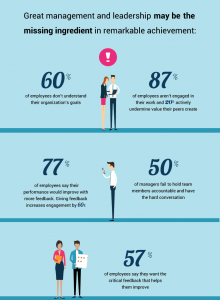Limited-term opt-out has become a standard feature in email marketing workflows. Here are some factors to consider before creating one.
Father’s Day is on its way, being celebrated on June 18 in both the U.K. and the U.S. Even if I weren’t already attuned to the date because of all the fathers in my life, I would know the day is coming because the Father’s Day emails are rolling in.
These emails aren’t just gift guides and date reminders. In what has become another holiday or event tradition, my inbox is filling up with offers to unsubscribe from Father’s Day emails in case I find them upsetting.
Here’s an example from Ace Puzzles:
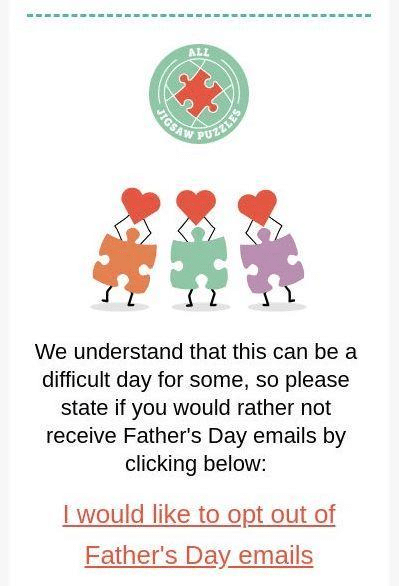
For many brands, the limited-term opt-out has become another step in the email workflow. Its value has also generated an ongoing debate among email marketers.
Is the holiday or event email a worthy effort that shows customers your brand cares about their well-being? Or does it end up doing what you tried not to do? That is, remind them about a holiday or event they’d just as soon avoid.
Do customers like the idea of opting out of holiday or event emails?
On the face of it, yes. Here are five findings from a 2022 consumer study by Capterra:
- 81% said they would buy from brands that send holiday opt-out emails.
- 68% of respondents said brands should “prioritize consumer well-being over sales,” especially during the winter holidays.
- 39% said they always or usually take the opt-out.
- 19% of consumers said they’re “personally sensitive” to holiday or event marketing emails, 32% said they believe other people are more triggered, and 7% said they make them feel sad.
- Generation Z consumers and men are more likely to take brands up on their opt-out offers.
Now, guess what the top opt-out events are. Mother’s Day? No. Father’s Day? Uh-uh. They’re Back to School and Valentine’s Day. Mother’s Day/Father’s Day are close runners-up but they’re in a pack that includes Thanksgiving Day and the winter holidays.
Holiday opt-outs as a sign of empathy
I applaud brands taking the time to evaluate how their emails affect their customers, whether by reassessing frequency, reviewing the kinds of campaigns they rely on, or using what they learn about their customers through analytics and testing to bring changes.
We learned a big lesson during the COVID-19 pandemic — brands that reached out in empathy to embrace customers under challenging circumstances often found customers appreciated and rewarded their efforts. Although some brands later returned to business as usual, others used what they learned to take a more customer-centric approach and revamp their email programs.
As marketers and human beings, we all know that some holidays are more difficult than others. Getting a barrage of Valentine’s Day emails just after breaking up with someone can be brutal. So, too, can receiving a Mother’s Day or Father’s Day email just before or after a death.
This trend began in the U.K. in 2019 when florist Bloom & Wild sent a simple email with the subject line “Want to opt out of Mother’s Day emails? No problem.” The company also allows customers to opt out of Father’s Day and Grandparent’s Day emails.
Other brands have taken up the cause. In the image below, Arena Flowers, a U.K. competitor, allows customers to opt out of two potentially triggering emails at once: Valentine’s Day and Mother’s Day, which follows closely on its heels in the U.K.
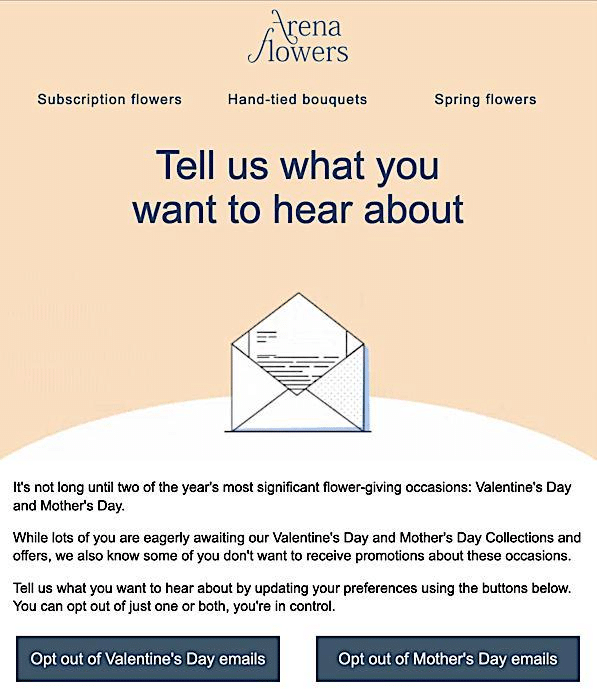
Holiday opt-outs also give customers more of a voice in the emails they receive, and I’m all for that. Giving customers more agency in the emails that come into their inboxes helps them feel more engaged with your brand and — in theory, at least — reduces the chance that they’ll unsubscribe, report your emails as spam or simply ignore them.
So far, so good. So, why do I not encourage consumer brands to jump into holiday or event opt-outs? Because there are better ways to recognize your customers’ emotional needs without creating more work for your email team or suppressing them from your email campaigns.
6 unintended effects of holiday opt-outs
Below are some factors to consider before you create your first holiday opt-out email campaign.
1. Consumers’ actions don’t align with opt-out preferences
Although consumers in the Capterra study showed a willingness to opt out from specific holidays, the 2023 Consumer Email Tracker published recently by the Data & Marketing Association (U.K.) and Deployteq found options like short-term options or changing preferences ranked below “Just rather unsubscribe” as options for dealing with unwanted email.
2. You might do more harm than good
Your heart’s in the right place with a holiday opt-out program. But you must raise your sights and look beyond your own interactions with your customers. Think about their inbox experience and all the other brands sending opt-out requests simultaneously, especially around high-intensity holidays like Mother’s Day.
Your email could add to that flood! Imagine all the mental labor a customer has to go through to opt out of all those emails, not to mention the added stress for customers who find those emails distressing. They might choose to disengage, and you will have lost a customer.
3. A preference center probably won’t solve the problem
Many of the emails I reviewed in the eDatasource (SparkPost) database direct customers to a preference center if they want to opt out of holiday or event emails. But most preference centers aren’t terribly user-friendly. You ask them to take time out of their days to say no to your email. If they’re on their mobile phones, tapping a collection of tiny boxes can be aggravating.
Also, a holiday that’s triggering this year (like Valentine’s Day after a breakup) might not be such a problem next year. Do you expect them to go back and update their preferences? Therein lies the problem with preference centers.
We all know the adage, “Listen to what someone does, not what they say.” The above results from Capterra were from a survey of people providing mindful responses, but how does it translate in real life? Do they really action what they say?
While this case study from Parcel.io on pausing emails isn’t specifically focused on pausing holiday and event emails, the aim was the same — to communicate with empathy and let the subscriber take control. The results? 98% of those who could have chosen to pause chose to opt out instead.
4. You’re introducing a negative aspect of the subscriber relationship
No matter how well-intentioned, your offer to opt out of holidays or events, even those as seemingly innocuous as Back to School, brings in a negative tone that wasn’t there before. Yes, the opt-out is temporary, and if you do it right, your customer needs to act only once.
Your messaging platform should send default campaigns during the opt-out period or automatically restart campaigns after the event. But you’re still interrupting the message flow.
5. A holiday opt-out adds to your email workflow
Depending on how many holidays you include in your opt-out program, you must first structure the program in your email platform. Can you program your platform to pause and restart campaigns, or will you have to do it manually? Can you segment your database or tag your opt-outs so that they receive only default campaigns?
Will you simply go dark during the opt-out period or send default campaigns? Who will create, test, schedule, troubleshoot and analyze those campaigns?
6. Account for regional holiday and audience differences
Let’s go back to Father’s Day for a moment. All of the opt-out offers I receive from U.S. or U.K. brands are technically irrelevant to me because my father lives in Australia. We celebrate Father’s Day on the first Sunday of September, not the third Sunday of June.
Mother’s Day also varies by several months in different countries. In the U.K., Mother’s Day is a movable holiday because it’s celebrated on the fourth Sunday of Lent before Easter, and the Lenten calendar can vary by several weeks from one year to the next. In the U.S. and Australia, Mother’s Day always falls on the second Sunday of May.
If your customer base is located mainly in one country or one whose holidays follow the same calendars as others, you might be able to get by with a single message. But if you have a global brand, you will need to be able to segment customers by country to avoid inadvertent irrelevance. Can you identify these population segments now?
Take these steps to develop an effective holiday email opt-out
It seems like a simple plan, but you need to do a lot of groundwork before writing that opt-out offer.
Begin with a goal and strategies
A holiday opt-out program isn’t a solution. It’s not even a strategy. It’s a tactic you use to carry out a strategy that will help you achieve your goal.
Your goal might be to retain more customers. One strategy to achieve that goal is to remove the friction from the customer relationship. To do so, avoid creating negative energy by letting customers opt out of holidays that bring on stressful feelings. As soon as you identify these three factors, you can study whether an opt-out program would support them.
Analyze your customers’ email activity before you jump into an opt-out offer
Look for lower open and click rates and higher unsubscribe rate around potentially triggering holidays.
- Can you measure read rates, delete-unopened rates and other activity metrics that indicate whether those customers are ignoring specific holiday or event emails?
- Do unsubscribes or activity rates go down around some holidays or events but not others, and is that consistent year to year?
What impact could it have on sales or other conversions?
If your finance people hate the idea of testing or holdout groups because of a potential loss of sales, they will love this approach. (Not!)
Let’s go back to the 39% of consumers who say they would opt out of holiday messaging. If you have 1 million subscribers on your list, but only 500,000 open or act on your emails, at least 195,000 subscribers will not see your most timely email campaigns. If you don’t substitute default campaigns, your revenue losses could be even higher.
Ask customers first
You could add a quick one- or two-question poll to a business-as-usual email campaign or send a short survey to a random sample of active subscribers. You also could poll your customer community or social media followers for their views (knowing that the views from a self-selected group might not reflect your subscriber base).
Add a holiday or event opt-out to your welcome/onboarding program
New customers are generally your most active and interested. So, capitalize on that interest and downplay the negative aspects associated with opt-outs by giving them an easy-to-use email structured to let them choose which future holidays and events to opt out of.
This works well also as the timing isn’t aligned with the flood of opt-out emails for a holiday or event and won’t add to the subscriber’s distress at that time of year.
Find a way to stand out in the inbox
Most of the emails I reviewed in eDatasource focused on the negative with subject lines like “Want to opt out of Mother’s Day emails?” You’ll need to think up and test new subject-line styles to stand out from other brands in the inbox and not aggravate or stress your customers. See an example from Brooks Running below for a good approach to this problem.
3 emails to emulate
To be honest, most of the opt-out emails I received or viewed in eDatasource did not achieve what they intended to achieve, in my opinion (sorry, marketers!). But a few did catch my attention:
Focusing on the positive
Brand: Shoppe Amber Interiors
Subject line: Customize your inbox: Opt-out of Mother’s Day emails with one click
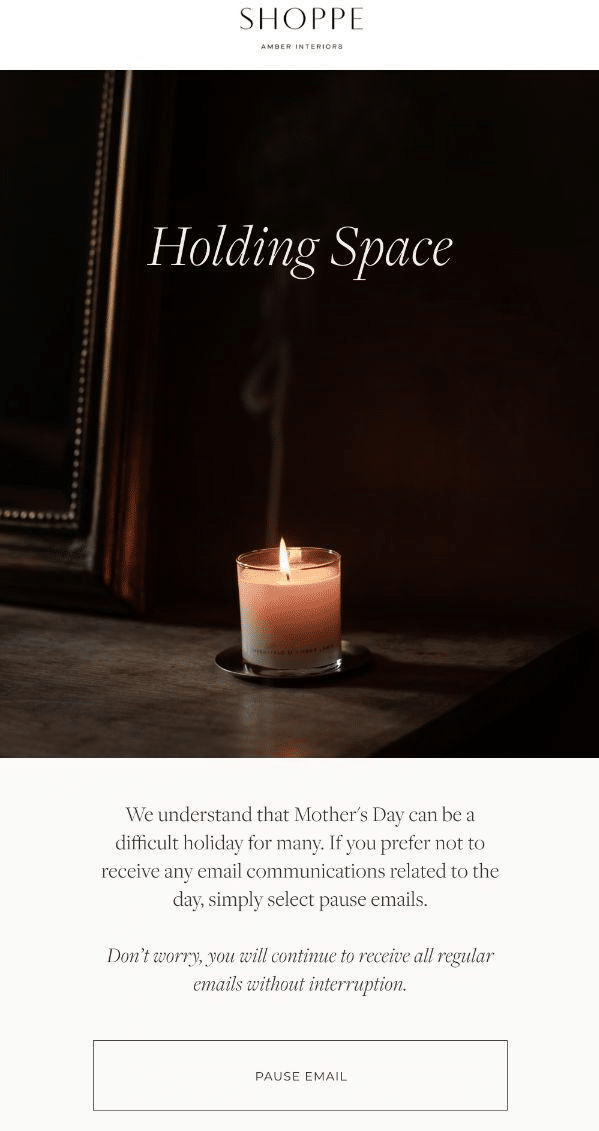
Why it works
The brand focuses on customizing emails instead of opting out, both in the subject line and the call to action: “Pause email.” It also reminds customers that they’re not opting out of all brand emails and will continue to receive other messages. Finally, the message is a subtle branding nudge because it resembles other brand images.
Including push notifications and SMS
Brand: Doordash
Subject line: Opt out of Mother’s Day messages?
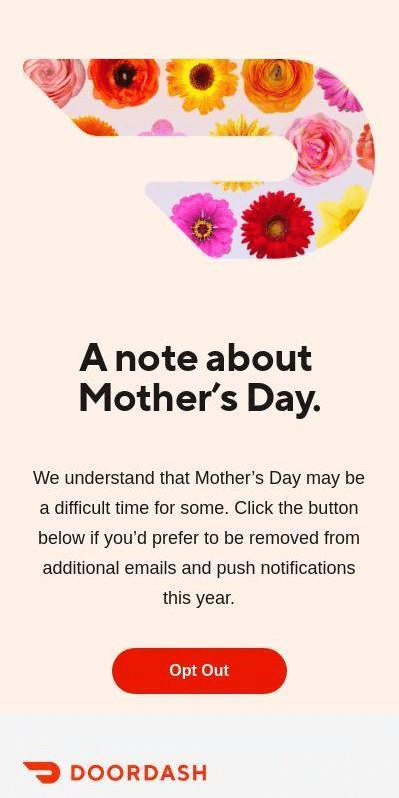
Why it works
In a multichannel world, it’s good to see a brand thinking through the entire messaging landscape. This email lets customers opt out of both email and push while assuring them they’ll still receive transactional and BAU campaigns.
Giving everyone a reason to click
Brand: Brooks Running
Subject line: Messages tailored to your preferences
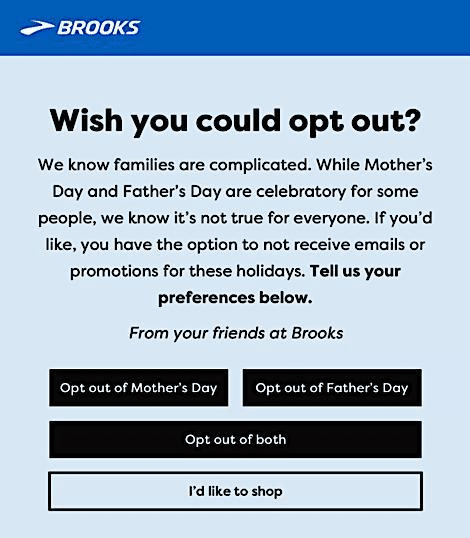
Why it works
When you focus on your goal, as this email does, you give more customers a reason to open, read and act on your message. Here, the four CTA buttons are clearly labeled and would be easy to click, even on a mobile screen.
The fourth CTA makes this email stand out: “I’d like to shop.” Besides giving your customers a chance to buy, you now know something about customers who click it that you didn’t before. They might be more motivated than others and could be segmented into another group for VIP treatment.
The post Holiday email opt-outs: Right intentions, wrong response? appeared first on MarTech.
(5)
